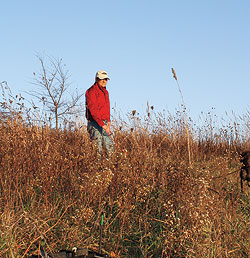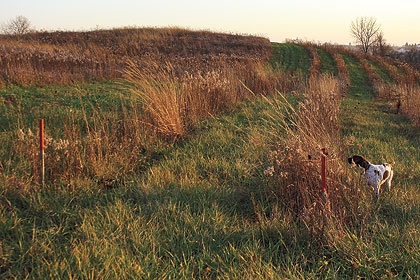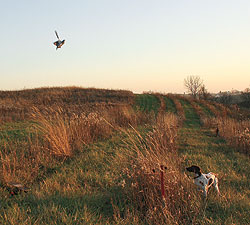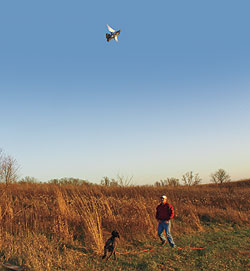Bird release traps are invaluable gun dog training tools for a variety of scenarios. Here are six different ways you can use them.
By Bob West
 A typical set-up used to awaken and nurture pointing instinct in young dogs. With trap positioned out of sight in cover, we swing the pup through the area, perpendicular to the wind/scent drift. Our objective is for the pup to suddenly get smacked with a nose full of bird scent, triggering pointing instinct. |
I'm sure most of you have at least seen some version of bird release traps in use, and no doubt many of you are using them, but for those who haven't quite made up their mind to add one or more to their "must have" training stuff arsenal I'll share some ideas on how they fit different phases of training.
Admittedly release traps aren't something I use every day, but I do own several and for certain aspects of training, like stopping to flush or nurturing pointing instinct in young pointing breeds, I feel they're pretty much the hot deal and earn their keep many times over.
A release trap is nothing more than a spring loaded bird cage. When triggered the mechanism springs upward, catapulting the bird clear of dog and cover, simulating a wild flush.
Most manufacturers use a pretty similar cage design; the differences come in the release mechanism, and that's where you find cost coming into play as well. These range from the basic models where you actually step on a release on the side of the trap, to those triggered by pulling a long cord and on to those that are truly remote, triggered electronically from any distance.
Although foot or string releases work in certain situations, for the full benefit of precise timing and a much broader range of uses, I recommend you bite the cost bullet and go for the full remote, electronic release.
Bottom line, "traps" are useful over a wide range of training scenarios, be it flushing, pointing, or retrieving work. They come in sizes for quail to ducks; the birds will be launched clear of your dog and cover for a clean flush with no need of dizzying; the birds are alert and ready for a strong flight, and we have precise control of when they flush.
This might sound like remote traps are the final answer but they're like any other training device. You have to realize they're not a cure-all or short cut. Supportive training and introductions are key, and as with any tool, overuse can lead to problems.
With that, let's share some ways release traps might fit your training program.
 Using a remote releaser is a great way to train and reinforce stop-to-flush on wild flushes. Set up a release trap in reasonable cover and swing your dog close but upwind of the trap. As the dog comes through the area, you can simulate a wild flush by popping the bird and at the same time be ready to reinforce the stop and steadiness. |
Marked Retrieves
When working to improve a retriever's marking ability and/or steadiness, I sometimes place traps around a pond or out in a flat field area. The trap takes the place of a helper and throws the birds at my signal. By throwing wing-clipped pigeons from a release designed for pheasants, I get pretty good height and the dog can easily marks the bird's fall.
With the traps set up, heel and sit your dog on line in clear view of the area of the trap and cue him with "Mark!" Be sure the dog is watching, then pop the wing-clipped bird.
At the same time you can fire a blank if you're working on steadying, then pause and send your dog for the retrieve.


RELATED READ: Beeper Collar Training Tips


On deli
very remember to sit the dog in line with the next trap, then accept the bird. Now as before, show your dog the line to the next trap with an extended hand and caution him to "Mark." As he looks downline, pop the bird and send him with "fetch."
Strong Flush
A flushing dog's job is to locate and force birds from cover into flight. One problem during training is that planted birds are often slow to flush and can be caught by the dog.
With release traps set up in heavy cover, we can watch our dog as it makes game and drives in for the flush, a case where timing is critical. With a release trap we're able to quickly catapult the bird, simulating a successful flush.
 Be ready to "whoa" or correct your dog as needed. Once he has proven steady you can release or call the dog to you for a job well done. Not everyone requires this level of steadiness, but it pays dividends in a dependable and well-rounded gun dog. |
Intense Pointing
An ongoing problem when working a young or unsteady pointing dog on planted birds is the possibility of him catching the birds in cover. When using a releaser, if the dog moves or breaks point, you can pop the bird clear like a wild flush. After a few of these most young dogs realize they can't catch the bird and the instinct to point kicks in.
This is a great way to let young dogs steady themselves. In days past with higher populations of birds, handlers simply let pups bump and chase until natural pointing manifested itself. Now we can do the same with release traps.
Usually beginning with the dog on a check rope, we work the young dog in perpendicular to the wind/scent drift so he gets a smack of scent all at once, hopefully triggering the pointing instinct. If this doesn't happen, you might keep a little pressure on the rope at first but once the pup pauses, relax the rope and be ready.
When the pup makes any motion toward the bird, pop the releaser and let him chase, saying nothing. Usually after a number of these sessions you'll see the pup begin pointing on his own.
Stop To Flush
Traps are often used to reinforce the initial stop and required steadiness following a wild flush or accidental bump. In a typical example, a whoa-trained/steady dog fitted with a check rope or remote training collar is worked into a field area off wind of the release trap. The idea is to handle the dog close but off wind so he can't catch scent, is unaware and startled when the bird is launched and freezes, leaving the handler in position to enforce obedience.
Backing
Our objectives are to either awaken and nurture the natural backing instinct or develop a learned obedience to stop upon seeing another dog on point. This ensures the backing dog stops clear of the pointing dog and doesn't interfere.
Position a steady dog on point in cover or over a rise so the backing dog doesn't see it as he approaches. These sessions work best if our backing dog abruptly notices an unmistakable side view of the pointing dog. At that instant, if the backing dog continues moving, we might caution or force him to honor.
 The benefit of a remote releaser is having the ability to pop the bird at any instant the pup moves. After a few repetitions, the pointing instinct is really enhanced as young dogs learn any movement causes the bird to go out€¦just like they'll experience with wild birds during actual hunting. |
In early sessions we caution or "whoa" the young dog to back, but the dog must eventually learn to stop of his own volition on seeing the pointing dog without command.
Once the backing dog has stopped and is honoring the point, the trap can be released and the bird shot. Often as a reward the backing dog is allowed the retrieve.
Reinforce As a hunting dog matures and training progresses, sessions are forced toward a closer simulation of the actual hunt. If you want control while hunting, advanced training sessions have to be as realistic as possible, with you in control and able to enforce obedience while exposing the dog to the excitement and distractions and ever-changing possibilities of the hunt.


RELATED READ: 32 Tips For Choosing and Using Modern E-Collars


When training on liberated birds your dog may get away with working in too close or taking "one more step" before pointing. Wild birds aren't so tolerant and may flush wildly at the slightest threat. Your dog should learn that extra step will cause birds to leave. In this application the remote traps are really effective in enabling the trainer, at any instant, to pop the bird for a good clean flush if the dog pushes too close.
Any one of the foregoing scenarios could easily support an entire article, and we may just address some of those in the future, but for now you have the idea and see how a remote releaser might be a helpful addition to your program. If you're interested check out the ads in this magazine and quality sporting catalogs like Lion Country or Cabela's, or Gun Dog Supply on the web, for ideas of what's available.






